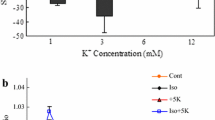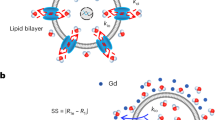Summary
1. The aim of this study was to elucidate if the K+ uptake was higher in cultured human glioma cells than in cells from other malignant tumors and to analyze the importance of membrane potential and K+ channels for the uptake.
2. K+ transport properties were studied with the isotopes42K and the K-analogue201Tl.
3. Comparison with cultured cells from other malignant tumors showed that the specific steady-state accumulation of Tl+ was significantly higher in glioma cells (U-251MG and Tp-378MG).
4. In Ringer's solution at 37°C the rates of K+ and Tl+ uptake were both inhibited by about 55% in ouabain and 60% in furosemide, bumetanide, or Na+-or Cl−-free medium. This indicated that the routes for K+ and Tl+ uptake were similar and due to Na,K-ATPase-dependent transport and to Na-K-Cl cotransport.
5. About 10% of the uptake was neither ouabain nor bumetanide sensitive. Ba2+, which is known to block inward-rectifying K+ channels and to depolarize glial cells, and other K+ channel blockers (Cs+ and bupivacaine), had no effect on Tl+ uptake.
6. Metabolic inhibition with dinitrophenol reduced the uptake rate to 17%.
7. The washout of Tl+ was unaffected by bumetanide and K+ channel blockers, but dinitrophenol caused a transient increase of 75%, an effect which persisted in the presence of K+ channel blockers.
8. It was concluded that the high specific K+ and Tl+ accumulation in cultured human glioma cells was due not to the presence of inwardly rectifying K+ channels or other identified K+ channels, but to Na,K-ATPase dependent transport and Na-K-Cl cotransport.
Similar content being viewed by others
References
Barres, B. A., Chun, L. L. Y., and Corey, D. P. (1988). Ion channel expression by white matter glia. I. Type 2 astrocytes and oligodendrocytes.Glia 110–30.
Brismar, T., and Collins, V. P. (1989a). Inward rectifying potassium channels in human malignant glioma cells.Brain Res. 480249–258.
Brismar, T., and Collins, V. P. (1989b). Potassium and sodium channels in human malignant glioma cells.Brain Res. 480259–267.
Brismar, T., and Collins, V. P. (1993). Effect of external cation concentration and metabolic inhibitors on membrane potential of human glial cells.J. Physiol. (Lond.) 460365–383.
Brismar, T., Collins, V. P., and Kesselberg, M. (1989). Thallium-201 uptake relates to membrane potential and potassium permeability in human glioma cells.Brain Res. 50030–36.
Brismar, T., Lefvert, A., and Jondal, M. (1994). A method for analysis of cellular K-transport mechanisms through thallium (201Tl) uptake in human lymphocytes.Acta Physiol Scand. 150299–303.
Chipperfield, A. R. (1986). The (Na+-K+-Cl−) co-transport system.Clinical Science 71465–476.
Hertz, L. (1978). An intense potassium uptake into astrocytes, its further enhancement by high concentrations of potassium, and its possible involvement in potassium homeostasis at the cellular level.Brain Res. 145202–208.
Hille, B. (1992).Ionic Channels of Excitable Membranes, 2nd ed., Sinauer Assoc., Sunderland MA, p. 131.
Kimelberg, H. K. (1974). Active potassium transport and [Na+ + K+]ATPase activity in cultured glioma and neuroblastoma cells.J. Neurochem. 22971–976.
Kimelberg, H. K., and Frangakis, M. V. (1985). Furosemide- and bumetanide-sensitive ion transport and volume control in primary astrocyte cultures from rat brain.Brain Res. 361125–134.
Kimelberg, H. K., Bowman, C., Biddlecome, S., and Bourke, R. S. (1979). Cation transport and membrane potential properties of primary astroglial cultures from neonatal rat brains.Brain Res. 177533–550.
Koh, D.-S., Jonas, P., Bräu, M. E., and Vogel, W. (1992). A TEA-insensitive flickering potassium channel active around the resting potential in myelinated nerve.J. Membr. Biol. 130149–162.
Newman, E. A. (1985a). Membrane physiology of retinal glial (Müller) cells.J. Neurosci. 52225–2239.
Newman, E. A. (1985b). Voltage-dependent calcium and potassium channels in retinal glial cells.Nature (Lond.) 317809–811.
Ransom, B. R., and Sontheimer, H. (1992). The neurophysiology of glial cells.J. Clin. Neurophysiol. 9224–251.
Reichelt, W., and Pannicke, T. (1993). Voltage-dependent K+ currents in guinea pig Müller (glial) cells show different sensitivities to blockade by Ba2+.Neurosci. Lett. 15515–18.
Saier, M. H., and Boyden, D. A. (1984). Mechanism, regulation and physiological significance of the loop diuretic-sensitive NaCl/KCl symport system in animal cells.Mol. Cell. Biochem. 5911–32.
Tas, P. W. L., Massa, P. T., and Koschel, K. (1986). Preliminary characterization of an Na+, K+, Cl− co-transport activity in cultured human astrocytes.Neurosci. Lett. 70369–373.
Tas, P. W. L., Massa, P. T., Kress, H. G., and Koschel, K. (1987). Characterization of an Na+/K+/Cl− co-transport in primary cultures of rat astrocytes.Biochim. Biophys. Acta 903411–416.
Walz, W. (1992). Role of Na/K/Cl cotransport in astrocytes.Can. J. Physiol. Pharmacol. 70S260-S262.
Walz, W., and Hinks, E. C. (1985). Carrier-mediated KCl accumulation accompanied by water movements is involved in the control of physiological K+ levels by astrocytes.Brain Res. 34344–51.
Walz, W., Shargool, M., and Hertz, L. (1984). Barium-induced inhibition of K+ transport mechanisms in cortical astrocytes—its possible contribution to the large Ba2+-evoked extracellular K+ signal in brain.Neuroscience 13945–949.
Author information
Authors and Affiliations
Rights and permissions
About this article
Cite this article
Brismar, T., Anderson, S. & Collins, V.P. Mechanism of high K+ and Tl+ uptake in cultured human glioma cells. Cell Mol Neurobiol 15, 351–360 (1995). https://doi.org/10.1007/BF02089945
Received:
Accepted:
Issue Date:
DOI: https://doi.org/10.1007/BF02089945




